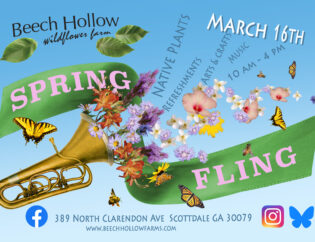When explaining the need for native plants in the landscape we often talk about the need for a constant supply of food, namely blooming flowers, for pollinators, and how planting groups of plants with successive bloom times throughout the year will ensure that your pollinators always have plenty to eat. It requires a bit of forethought and research (or just ask us), but the rewards are flowers and bees/butterflies/birds in your yard all year. That sort of long term planning is also useful when thinking about your the physical setting where you want to put your plants (i.e. your yard).
Botanists refer to naturally occurring groups of different plant species as ‘communities;’ and there are LOTS of them. The Natural Communities of Georgia is a massive 700 page book that exquisitely details the plant species that occur in each little environmental variation of a given area in Georgia. It just came out last year, and at $60 it’s a steal. If you REALLY want to get to know the flora of the land you inhabit, this is THE reference you need. Digression aside, there are many, many combinations of plants that naturally occur together. The particular mix of geology, slope, aspect, moisture, light, wildfire, animals, and many other variables that make up a landscape determine what plants are able to survive and thrive there.

When we introduce the human decision making process to the equation with the question “What shall I plant?” we can all take a lesson from nature. By studying communities one can learn much about how every niche can be filled with a plant. Permaculturists such as Bill Mollison and Toby Hemenway have popularized the concepts of ‘guilds’ and ‘plant stacking’ to describe attempts to emulate natural communities and succession processes with human plantings. The guild is basically a radial planting pattern with a central focal point, most often a tree or large woody shrub.
Midwest Permaculture has an awesome e-booklet (.pdf) available for free that explains this concept way better than I can with fancy graphics and examples of guilds for many different species of tree. The Oak guild (pg. 13) should be of interest to most people in the Piedmont.
Plant stacking refers to the use of vertical space through time. In a mature guild you would have your (top to bottom) canopy trees, midstory or sub-canopy trees, understory trees, woody shrubs, and the herbaceous ground layer. This space also moves through cyclical time each day and year, with the daily and seasonal weather variations offering dynamic microclimates for a diverse collection of plants. But we don’t all have mature trees just ready and waiting for those spring bulbs underneath. If you start with a four foot tall oak sapling (or an acorn!) you can maximize the space by planting a fast growing, short-lived tree or shrub that will also help shield the young oak from wind and harsh temperature changes.
Pictured above are a few of the layers in a mature Oak-Hickory-Pine canopy in an Atlanta park. Ground layer, top left, is covered with Virginia Creeper (Parthenocissus quinquefolia), Muscadine (Vitis rotundifolia) and Greenbrier (Smilax sp.) among others; Shrub layer, top right, has an Oak-Leaf Hydrangea (Hydrangea quercifolia); Understory has a Flowering Dogwood (Cornus floridus) beneath an Oak; the midstory and canopy are occupied by a mix of Hickory (Carya sp.), Oak (Quercus sp.), Tulip Poplar (Liriodendron tulipifera), Pine (Pinus sp.) and Magnolia (Magnolia sp.).
So, finally we arrive at the Modules. This is a concept from Douglas Tallamy. Modules are guilds of native plants that can be thought of as interconnecting “modular” units. They can repeat or interlock with other guilds by using the same edge species (understory trees most often). It’s a great way to start visualizing just how we can start to restore native plants in the landscape one unit at a time. Mr. Tallamy’s examples of modules will help (.pdf)
Tallamy hits the nail on the head in the first paragraph: “Many people who have decided to rebuild native plant communities in their yards become quickly overwhelmed with the decisions that have to be made when it comes to selecting plants. For any given locality there are often dozens of possibilities; which ones are best? Which species work well together? Which are available in local nurseries?”
We’re trying really hard to answer that last question. I hope that all this information has got you asking some questions of your own such as: “Is there room for a fruiting understory tree in my canopy?” or “What is a good shrub layer for the dry, shady hillside out back?”
Here are a few more references to boot:
- Doug Tallamy’s ‘Best Bets’: Native woody and herbaceous plants listed by number of caterpillars they host. A must for butterfly gardeners.
- ‘Plant Communities of the Georgia Piedmont’ by Connie Gray details many of the native plants and where they are found within each community.











